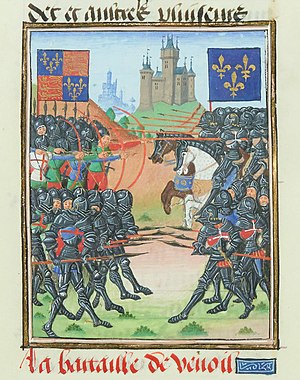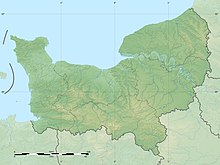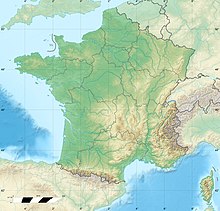
Back Битка при Верньой Bulgarian Setge de Verneuil Catalan Schlacht von Verneuil German Batalla de Verneuil Spanish Bataille de Verneuil (1424) French Վերնեյի ճակատամարտ Armenian Battaglia di Verneuil Italian ヴェルヌイユの戦い Japanese ვერნოს ბრძოლა Georgian Slag bij Verneuil Dutch
| Battle of Verneuil | |||||||
|---|---|---|---|---|---|---|---|
| Part of the Hundred Years' War | |||||||
 Illumination from La Cronicque du temps de Tres Chrestien Roy Charles, septisme de ce nom, roy de France by Jean Chartier, c. 1470–1479 | |||||||
| |||||||
| Belligerents | |||||||
|
Kingdom of France Kingdom of Scotland Supported by: Duchy of Milan | Kingdom of England | ||||||
| Commanders and leaders | |||||||
|
Count of Aumale † Earl of Douglas † Earl of Buchan † Viscount of Narbonne † |
Duke of Bedford Earl of Salisbury | ||||||
| Strength | |||||||
| 14,000–16,000[2] | 8,000–9,000[3] | ||||||
| Casualties and losses | |||||||
|
6,000 killed[4] 200 captured | 1,600 killed[5] | ||||||
Location within Normandy | |||||||
The Battle of Verneuil was a battle of the Hundred Years' War, fought on 17 August 1424 near Verneuil-sur-Avre in Normandy between an English army and a combined Franco-Scottish force, augmented by Milanese heavy cavalry. The battle was a significant English victory, and was described by them as a second Agincourt.
The battle started with a short archery exchange between English longbowmen and Scottish archers, after which the force of 2,000 Milanese heavy cavalry charged the English, brushed aside an ineffective English arrow barrage and wooden archer's stakes, penetrated the formation of English men-at-arms and routed one wing of their longbowmen. The Milanese pursued the fleeing English off the field and went on to capture and loot the English baggage train. Meanwhile, the well-armoured English and Franco-Scottish men-at-arms clashed on foot in a ferocious hand-to-hand melee that went on for about 45 minutes. Many of the English longbowmen rallied and joined the struggle. The French men-at-arms eventually routed, leaving the Scots alone in a last stand where they received no quarter from the English. The Milanese cavalry returned to the field at the end of the battle but fled upon discovering the fate of the Franco-Scottish force.
Altogether some 6,000 French and Scottish were killed and 200 taken prisoner.[6][7] The Burgundian chronicler Jean de Wavrin, who fought in the battle, estimated 1,600 English killed, although the English commander, John, Duke of Bedford, claimed to have lost only two men-at-arms and "a very few archers". The Scots army, led by the earls of Douglas and Buchan (both of whom were killed in the battle), was almost destroyed. Many French nobles were taken prisoner, among them the Duke of Alençon and the Marshal de La Fayette. After Verneuil, the English were able to consolidate their position in Normandy. The Army of Scotland as a distinct unit ceased to play a significant part in the Hundred Years' War, although many Scots remained in French service.
- ^ Eggenberger 1985, p. 460.
- ^ Burne 1956, pp. 213, 344.
- ^ Burne 1956, pp. 202, 212.
- ^ Tucker, Spencer C. (23 December 2009). A Global Chronology of Conflict: From the Ancient World to the Modern Middle East [6 volumes]: From the Ancient World to the Modern Middle East. ABC-CLIO. p. 330. ISBN 978-1-85109-672-5.
- ^ Tucker, Spencer C. (23 December 2009). A Global Chronology of Conflict: From the Ancient World to the Modern Middle East [6 volumes]: From the Ancient World to the Modern Middle East. ABC-CLIO. p. 330. ISBN 978-1-85109-672-5.
- ^ Tucker, Spencer C. (23 December 2009). A Global Chronology of Conflict: From the Ancient World to the Modern Middle East [6 volumes]: From the Ancient World to the Modern Middle East. ABC-CLIO. p. 330. ISBN 978-1-85109-672-5.
- ^ Myers 1995, p. 234.
© MMXXIII Rich X Search. We shall prevail. All rights reserved. Rich X Search

